Past Productions
The works presented by Dublin Lyric are listed below starting with the most recent production. The first play was 'Purgatory' by W B Yeats and it was performed in April 2005 at the National Library in Dublin.
January – February 2019 - 'Girls in Silk Kimonos' in the National Libray, Dublin
 Constance Markievicz with her daughter Maeve and stepson Stanislaw, at Lissadell House, Sligo.
Constance Markievicz with her daughter Maeve and stepson Stanislaw, at Lissadell House, Sligo.Dublin Lyric, in association with the National Library, presented a performance of Girls in Silk Kimonos at the National Library, Kildare Street, Dublin in the Mezzanine Room on three evenings in January & February 2019.
The play, by the late Miriam Gallagher, centres on the correspondence between Constance Markievicz and her sister Eva Gore-Booth. After the performance, director Conor O'Malley leads a lively discussion with members of the audience.
The acting team was Mia Gallagher and Una McNulty in the roles of Constance and Eva respectively; and Declan Brennan in the role of Narrator.
The reading was directed by Conor O'Malley and music was provided by Ciaran Tourish of Áltan and MJ Sullivan sang James Connolly by Patrick Galvin:
Visit the page for the play for more about Girls in Silk Kimonos.
January to November 2016 - 'Pull Down a Horseman' throughout Ireland, North & South
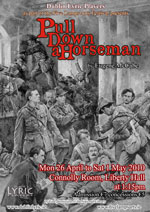
Pull Down a Horseman is about what might have transpired in a private session between Patrick Pearse and James Connolly after a three day meeting with members of the IRB leadership in January 1916. They discuss, debate, argue and verbally joust with one another over whether and when to go ahead with the Rising. After a short introduction to the performance, the play ran for just over thirty five minutes and was followed by a post-show discussion.
Patrick Pearse was played by Declan Brennan and James Connolly was played by MJ Sullivan. During the play a fascinating insight into the two characters emerges. They were two very different people — intellectually well matched, but with very different political philosophies and perspectives.
Visit the page for the play for more about Pull Down a Horseman.
April 2010 - 'Within the Gates' at Liberty Hall
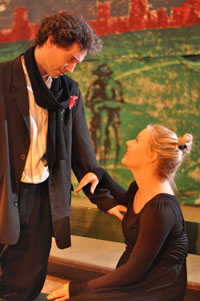
'Within the Gates' by Sean O'Casey is an intriguing, experimental and expressionist play, written in the late 1920s and published in 1934.
The play is set around Speakers’ Corner in London's Hyde Park, during the four Seasons of the year. The life of a Young Woman is gradually unfolded through her inter-actions with the visitors to the Park, and as she stumbles through the seasons of her own life. O’Casey paints the broadest of human canvases in bold colours. What he portrays is the bitter, but fulsome life of a feisty, impressionable and vulnerable girl who becomes transformed during the Seasons from a girl to a woman, later to re-emerge as an archetypal representative of humanity. The renowned dramatic critic George Sean Nathan wrote that the play “…is one of the most beautiful plays I have read in a very long, long time. It has an overwhelming beauty.”
The performances were part of the Five Lamps Festival in Dublin, which ran from 22nd April 2010 to early May. The year 2010 was the third time that the Festival, an initiative of Marino College of Further Education, was run by a group of volunteers interested in promoting the arts in the centre of the city. It is supported by Dublin City Council’s Arts Office and Marino College of Further Education CDVEC.
Dublin Lyric performed 'Within the Gates' in the Larkin Room and 'Pull Down a Horseman' by Eugene McCabe at a series of lunchtime performances in the Connolly Room also in Liberty Hall.
Apart from drama, the Festival events included exhibitions of visual art, puppet theatre, mine and music. Some of the events were free to the public.
More information about the play and the actors, pictures taken and an audio recording made at one of the performances of the play can be found on the page for the play. An image of the poster is here.
July/August 2009 - 'The Only Jealousy of Emer' at the National Library
'The Only Jealousy of Emer' was presented as part of the Summer Lunch Plays Programme at The National Library, Kildare St, Dublin towards the end of July and the first week of August 2009.
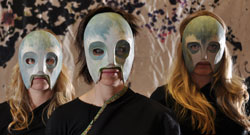
Following on from 'On Baile's Strand', it takes up the story of Cuchulain's fight with the sea. In this play, the wife of the warrior-king is faced with a choice - to lose her husband to death or surrender something that she regards as being almost as precious.
The play was in the National Library, Kildare Street, Dublin from 28 to 31 July and from 4 to 7 August each day at 1:15pm.
This play by W B Yeats is told using the format of the Japanese Noh theatre. More information about the play, its stylised form, profiles of the actors and pictures taken after the last performance of the play on Friday 7 August 2009 can be found on the page for the play. An image of the poster is here.
In addition, as part of the Summer Lunch Plays Programme, 'The Cat and the Moon' was presented in the Seminar Room of the National Library in July 2009 (see details below). 'The Cat and the Moon' and 'The Only Jealousy of Emer' were directed by Olivia Pouyanne.
July 2009 - 'The Life of Galileo'
Marking 2009 as The International Year of Astronomy, Dublin Lyric presented a production of the classic play about the Italian scientist and philosopher Galileo Galilei in Dublin in the 'The Atrium', a performance space at the centre of the headquarters of the Office of Public Works on St Stephen's Green, Dublin. The play was performed from Monday 13 to Friday 17 July 2009.
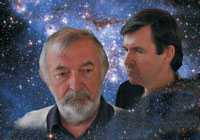
'The Life of Galileo' was written by the German dramatist Bertolt Brecht in the 1930s. The play covers the later period in Galileo's life and the story deals with the conflict between his scientific discoveries and the teachings of the Catholic Church. The powerful influences of science and religion on society are explored together with Galileo's personal struggle with the choices he made. Galileo’s discoveries, which convinced him that the Sun was the centre of the solar system, resulted in him being brought to trial by the Church and forced to deny the truth of what he learned about the universe. Brecht doesn't present an over-simplified black and white version of right and wrong. Galileo is not depicted as a perfect character. He is shown to be a man whose scientific achievements were as big as the universe he explored, but who was not always as farsighted in his dealings with the people around him. Following his agreement to recant his scientific beliefs, he spent the rest of his life under house arrest, but he continued to work on his research until he died in January 1642. Brecht's 'The Life of Galileo' is commonly regarded as a brilliant artistic expression of the mind and times of one of the most remarkable figures in world history and is also one of the finest plays written in the 20th century.
More background information and pictures are available here.
November 2008 -'Oedipus the King' and 'Oedipus at Colonus'
Two of Yeats’ finest plays which have been performed on just two previous occasions since 1927
King Oedipus and Oedipus at Colonus, among WB Yeats' finest dramatic works, have rarely been performed in Ireland. The previous occasions were in 1973, and before that in 1927-28, when they were performed at Dublin’s Abbey Theatre for the very first time.
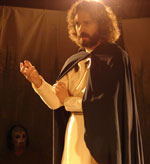
Regarded as two of Yeats’ most challenging dramatic works, these versions of Sophocles’ plays relate the great story from Ancient Greek Mythology of Oedipus, King of Thebes, who unknowingly kills his father, marries his mother and begets four children by her. The story is about how the Gods and his own actions bring about his downfall. In Yeats' version, the focus is on Oedipus's relentless and doomed search for the truth, on his catastrophic reaction to the knowledge of his incest and on his humanity.
While Yeats’ versions of King Oedipus and Oedipus at Colonus both incorporate splendid choral sequences (regarded as the finest created by any poet), they are mainly written in a superbly spare prose which makes them readily accessible to a wide audience.
The many fine performances included Patrick Dunne’s splendid, monumental portrayal of Oedipus, Sharon Hogan’s terror as Jocasta, Connolly Heron’s restraint in describing Oedipus’s death and the exquisitely expressed grief of Oedipus’ daughters, Antigone (Sarah Louise Cleary) and Ismene (Therese Mullan).
October 2008 (and July 2009) - 'The Cat and the Moon' at the National Library
Following a successful run towards the end of 2008, 'The Cat and the Moon' was presented again as part of the Summer Lunch Plays Programme at The National Library, Kildare St, Dublin in July 2009.
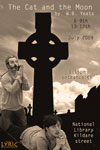
Two beggars, one lame and one blind, journey to the holy well of St. Colman, hoping to be cured. A saint offers them the choice of blessedness or physical well being..... so the little morality tale of The Cat and the Moon unfolds as the beggars begin to wrestle with their respective choices.... and consequences. Variously categorised as a Japanese Noh play, a folk drama and a farce, the play was first presented at the Abbey theatre in 1926, directed by Lennox Robinson under the supervision of Yeats. The play also has the distinction of being the immediate precursor to Yeats' Oedipus plays.
This production marked the directorial debut of Olivia Pouyanne who played the Angel, and whose speaking of Yeats chorus’s in Dublin Lyric’s Noh plays is redolent of clarity and authority.
This comedy by W B Yeats is told using the format of the Japanese Noh theatre. A larger image of the poster, which was used to promote the play, can be seen in a popup window here.
October 2007 - 'The Hour Glass' at the National Library
A morality play for modern times. As in the great medieval play, Everyman, the philosopher or Wise Man is commanded to set his house in order before the sands of his time run out.
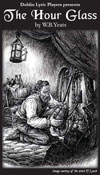
During the play the wisdom of the Fool is pitted against the intellect of the Wise Man and many themes are woven together including the enmity of reason and mysticism. The Hour Glass, an original version of which was written in collaboration with Lady Gregory, has the sceptical wise man arguing with the fool. The wise man has taught his pupils that there is nothing after death - afterlife is a fiction or wishful thinking. The fool contests this as he knows that angels walk the hills.
The Hour Glass is one of Yeats's most beautiful plays, nor least for its effortless weaving of fine poetry with the most universal of story lines.
The Dublin Lyric production is understood to have been the Dublin premiere of this verse version of the play. Paul Nolan gave a most precise and intelligent interpretation of The Wise Man and the performance of David Ferguson as the Fool giving, arguably, a definitive interpretation in this role.
July 2007 (and revived July 2008) - 'The Fantasticks' at the Mill Theatre, Dundrum, Dublin
The Fantasticks is an immensely popular musical which premiered in 1960, ran for over 17,000 performances, becoming the world's longest-running musical for over 40 years.
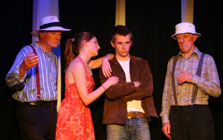
With music by Harvey Schmidt and lyrics by Tom Jones, it tells the story of two fathers who put a wall up between their houses to ensure that their two children do not fall in love. Inevitably, the boy and girl do fall in love, they discover their fathers' plot. They both decide to leave and experience the world separately. Eventually returning to the love they had. The poetic book and breezy, hummable score, including such familiar songs such as "Try to Remember", helped make this show so durable.
The Dublin Lyric production was the first in Ireland since the mid 1970s.
The presentation featured potentially important debut performances from young actors, Clare O’Malley and Peter Brooke Tyrell, both originating from Stillorgan Youth Musical Company (known as SYMCO).
May 2007 - 'The King's Threshold' and 'The Dreaming of the Bones'
at the National Library and as part of Culture Night in the National Museum
The King's Threshold, written in 1903, is about the role of the arts in society. The King's Threshold explores themes which came to figure significantly in Yeats' poetry: loyalty and love; the nature of the State and society, the place of poetry and the arts; the effect of commitment to a cause; and the heroic ideal in action.
Dublin Lyric gave this play its first Dublin production since then. Fine performances were represented by an austere Seanchan (Patrick Dunne) and the restrained emotion of his beloved Fedelm (Sarah Ryan) as she desperately seeks to draw him away from his sacrifice.
The Dreaming of the Bones is the poet's response, in dramatic form, to the events of Easter 1916 when a peasant, on the run after the rebellion, meets the ghosts of Dermot and Derogilla who brought the Norman to Ireland. The production featured finely judged performances by Tristan McConnell as Dermot and Sharon Coade as Dervogilla – and through their melancholy dance of un-fulfilled passion and love.
April 2007 - 'Pull Down a Horseman' by Eugene McCabe at the National Library
Eugene McCabe is one of Ireland's leading playwrights and is especially known for his play The King of the Castle.
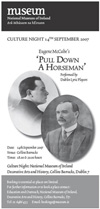
Pull Down a Horseman enacts a private meeting between Pearse and Connolly on whether and when to go ahead with the Rising. The dramatic conflict comes out of their expression of their differing political philosophies and perspectives. The incident described is based on best historical research. The play was written in 1966 to commemorate the Rising's 50th Anniversary.
The Dublin Lyric production is believed to have been the first performance of this play since its presentation at the Abbey Theatre in 1979. The production was Dublin Lyric’s first presentation “in the round” without stage lights – ably negotiated by the actors who portrayed Pearse (Declan Brennan) and Connolly (Alan Carey).
The play was first performed by Dublin Lyric in the National Library, Kildare Street, Dublin and later in the National Museum, Benburb Street, Dublin. The old Collins Barracks, which are now the museum, were home to soldiers (first British and then Irish) for 300 years. A presentational highlight was the performance in the National Museum and Pearse’s declamation “We have 10,000, the British Garrison has 10,000!”
A new production for the Centenary of the Easter 1916 Rising was presented in 2016 with Declan Brennan playing Patrick Pearse and MJ Sullivan playing James Connolly. Read more...
November 2006 - 'Yeats’ The Cuchulain Cycle' of plays at the National Library
Written between 1900 and 1939, The Cuchulain Cycle consisting of At the Hawk’s Well, On Baile’s Strand, The Only Jealousy of Emer and The Death of Cuchulain, is underpinned by the themes which dominate Yeats's poetry: the purpose of life and death; the significance of beauty and love; the place of action and commitment; and heroism an idealism.
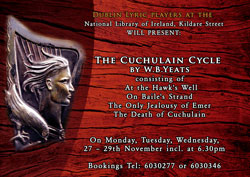
Among the heroes of Irish legend and mythology, Cuchulain is the strong, handsome, powerful character at the centre of the Ulster legends. It was he who single-handedly defended his province against the armies of the rest of Ireland.
These plays have not been performed often and a performance of all the plays in the cycle together is an even rarer event – the Dublin Lyric production is believed to have been only the third occasion on which the full Cycle has been produced in Dublin.
Included in many fine performances, were Michael Thornton’s dark and penetrating Old Man, Sharon Coade’s taut Aoife; Margaret Toomey’s powerfully descriptive Emer, and Alan Carey’s courageous performances of the mature, older and then dying Cuchulain.
'At the Hawk’s Well'
“The subject of the new play (At the Hawk’s Well) was one of Cuchulain’s adventures, but not one of the great events in the hero’s life available in the records of his deeds. Yeats aiming to penetrate into the depths of the mind, ignored the hero’s wonderful feats performed in the objective world and invented, instead, an incident to represent an event in the subjective worlds of individual spirit, the meeting of mortal and immortal that, taking place in Cuchulain’s youth, shapes his later destiny as hero. The action of At the Hawk’s Well concerns the protagonist’s spiritual birth as a tragic hero and has a temporal priority to Cuchulain’s later combats with the objective world.” Extracts from The Tragic Drama of W.B.Yeats by Leonard Nathan.
'The Only Jealousy of Emer'
“Yeats is a poet as much of fact as of feeling. Every work of his has a source—whether from folklore, legend, mythology, the occult, or history: each a source that for him had a definite objective reality. The demands of this world and of that other world of Yeatsian spiritual reality often conflict. His play The Only Jealousy of Emer, particularly in its early drafts, offers a vivid portrayal of such a struggle. It marks one of the turning points of Yeats’s career, because in its final form it is a synthesis of two profound experiences that were to shape his later work: his marriage to Georgie Hyde-Lees in 1917 brought him a certain degree of contentment with the joys of this world, while her automatic script provided a philosophical framework for his poems and plays.” Extract from “The Only Jealousy of Emer” and “Fighting the Waves” Manuscript Materials by W.B. Yeats edited by Steven Winnett, the Cornell Yeats
'The Death of Cuchulain'
The play was written in Yeats’ last year of his life, even to the extent of his making textual amendments in the weeks before he died. The work is like a dream play, written by a poet describing the images of what he sees, thinks and experiences as he goes in and out of consciousness. The mind, of course, is that of Yeats himself and his “circus animals” include the imaginative women in his life, Emer, Aoife, Eithne Inguba, the Morrigu.
The Death of Cuchulain is a complex play, and often underrated and underestimated and rarely performed on account of that - and the play presents interpretive challenges to any theatre company.
In a carefully modulated performance, Michael Thornton took on the role of the Old Man, building in layers to the last testament of Yeats – “I spit, I spit, I spit!” Olivia Pouyanne as the Morrigu, with restraint and deadly intent, prepared the dance: and Sarah Louise Cleary summarised the proceedings with Yeats’ final Chorus and words – “so ends the tale that the harlot/ Sang to the beggar man.”
Spring 2006 - 'Words upon the Window Pane' at the National Library; also presented at Coole Park
This play was first staged in 1930. A most powerful and brilliant dramatic exploration of the occult, in which Yeats had a lifelong interest.
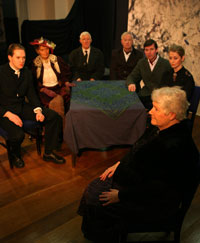
Written at Lady Gregory’s Coole Park estate, it features a séance in which Jonathan Swift’s voice is projected through a medium and the drama is provided through the medium’s enactment of the romantic triangle involving Jonathan Swift and two women, Vanessa and Stella and Swift’s evolving madness.
The play features a séance in which Jonathan Swift’s voice is projected through a medium. His spirit and those of his two lovers, Stella and Vanessa, emerge in a series of séances held in Dublin in 1928. It's a story of passion and torment where the individuals at the centre of the story and the characters who attend the séance are brought into a situation where they are forced to confront some aspects of their own lives.
One thing that Yeats had in common with Swift was that they were both politicians and poets. The use of Swift as the subject gave Yeats an opportunity to incorporate a political message into the drama.
Frances Blackburn who played the part of the medium was a vocal tour de force and the performance in Coole Park attended by some of Lady Gregory’s extended family was a most special occasion for all to remember.
Spring 2005 - 'Purgatory', 'At the Hawk’s Well' and 'The Dreaming of the Bones' at the National Library
Extract of note from Dublin Lyric’s first programme

“The plays of W.B. Yeats are some the most challenging in theatre for both audience and performer. In a style with poetry at its heart and where conventions of naturalist theatre count for little, these plays seek to apprehend the spectator by other means, through the establishment of formal atmosphere, through lyricism of language, tightly wrought narrative and expression of ideas, and through abstract dance, music and visual effects.
The basic principles of theatricality remain uppermost. His rarely performed plays provide a cornerstone for Irish theatre.”
.jpg)
